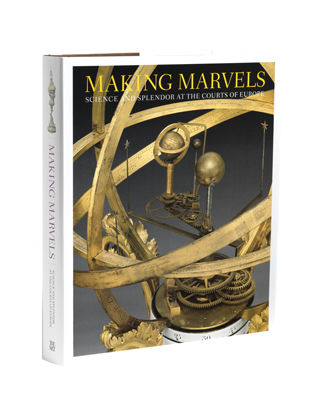
Presenting more than 150 rare and prestigious treasures, this beguiling volume explores the vital intersection of art, technology, and political power.
Buy NowBetween 1550 and 1750, nearly every royal family in Europe assembled vast collections of valuable and entertaining objects. Such lavish public spending and display of precious metals was considered an expression of power. Many princes also believed that the possession of artistic and technological innovations conveyed status, and these objects were often prominently showcased in elaborate court entertainments, which were characteristic of the period.
Making Marvels explores the complex ways in which the wondrous items collected by early modern European princes, and the contexts in which they were displayed, expressed these rulers' ability to govern. Approximately 170 objects—including clocks, automata, furniture, musical instruments, jewelry, paintings, sculptures, print media, and more—from both The Met collection and over fifty lenders worldwide are featured. Visitors will discover marvelous innovations that engaged and delighted the senses of the past, much like twenty-first-century technology holds our attention today—through suspense, surprise, and dramatic transformations.
Accompanied by a catalogue and picture album published by The Met.
"A trove of impossibly opulent European objects. . . . Enlivened by beautifully produced videos." —New Yorker
"A glistening reminder of the dizzying possibilities of scientific discovery—and humans' endless urge to show off what they know." —Washington Post
"Stupendous exhibition. . . . Demonstrations of early science as a form of transformational magic that characterized the world of the cabinet of curiosities." —Wall Street Journal
"Nothing sparkles like the 'Dresden Green'." —New York Times
"Wide-ranging and eclectic" —New York Review of Books
"A stupendous, verging-on-crackpot array of hybrid creations that . . . laid the groundwork for our gizmo-crowded lives." —Gothamist
"Destinati a lasciare il visitatore a bocca aperta (Destined to leave the visitor speechless) . . . " —ANSA
"Expect suspense, surprise, and dramatic transformations!" —Red Tricycle (Top Exhibition for Kids this Winter)
The exhibition and accompanying catalogue are made possible by the Anna-Maria and Stephen Kellen Foundation.
An incredible 41 carats, the "Dresden Green" diamond is the largest known natural green diamond. Read how the "Dresden Green" become a symbol of Saxon royalty.
Early modern rulers used scientific objects to express magnificence—but their "science" was more expansive than ours today. Read how alchemists innovated decorative arts.
Watch a playlist of fifteen automata, clocks, writing machines, and more.
Marquee: Gerhard Emmoser (German, active 1556–84). Celestial globe with clockwork, 1579. Austrian, Vienna. Partially gilded silver, gilded brass (case); brass, steel (movement); 10 3/4 x 8 x 7 1/2 in. (27.3 x 20.3 x 19.1 cm); diameter of globe: 5 1/2 in. (14 cm). The Metropolitan Museum of Art, New York, Gift of J. Pierpont Morgan, 1917 (17.190.636). Diamond: Franz Michael Diespach (before 1725–ca. 1791), incorporating pieces by Jean Jacques Pallard (1701–1776). Hat Ornament with the "Dresden Green" from the Diamond Garniture (detail), Dresden and Prague, 1769; older elements Vienna, 1746. Almond-shaped celadon-green diamond of 160 grains (approx. 41 carats); two round, brilliant-cut diamonds, one of 24 1/2 grains (approx. 6.28 carats), the other of unknown weight; 411 medium to small diamonds; silver; gold, 5 1/2 x 2 in. (14.1 x 5 cm). Grünes Gewölbe, Staatliche Kunstsammlungen Dresden (VIII 30)